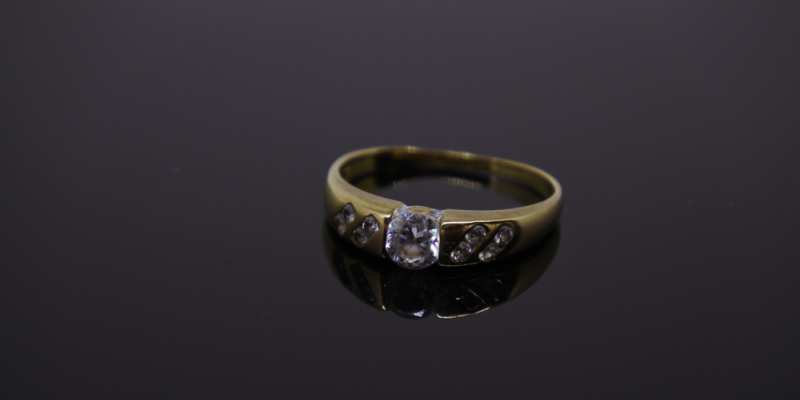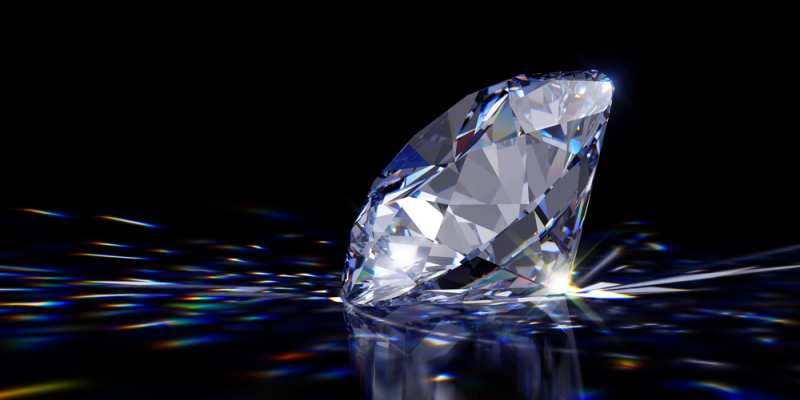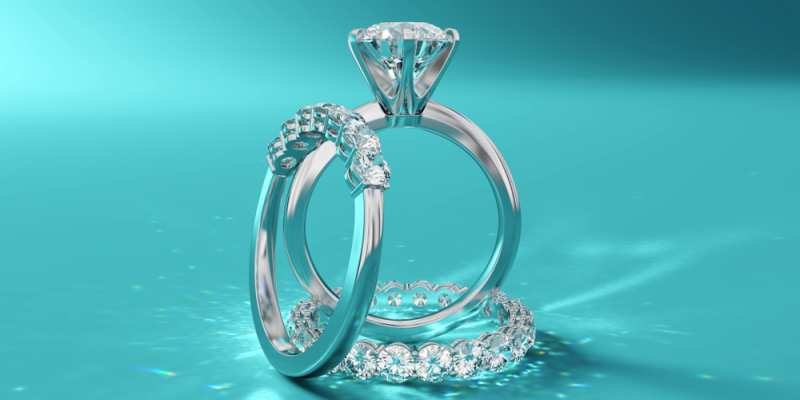If you’ve ever compared a loose diamond to the same diamond set in a piece of jewelry, you may have noticed that it appears larger when it’s set. This optical illusion has puzzled many, and today, we aim to unravel the mystery behind this phenomenon.
When it comes to materials that interact with light, visual phenomena like this are not uncommon. Diamonds, being highly reflective and refractive, can exhibit fascinating characteristics in certain circumstances.
Without further ado, let’s delve into the reasons behind this intriguing illusion and shed light on why diamonds appear larger when they are set in jewelry.
DESIGN YOUR OWN ENGAGEMENT RING: START WITH A SETTING OR START WITH A DIAMOND. IT’S REALLY UP TO YOU!

How Big Are Diamonds Usually?
Let’s begin by discussing the typical size of diamonds to provide context for our main topic.
The most common diamonds you’ll come across in jewelry stores are one-carat diamonds, weighing around 0.2 grams. These diamonds are widely used in various types of jewelry, including rings, necklaces, watches, and bracelets.
While larger diamonds do exist, they are relatively rare and won’t be our focus here. We’ll primarily be discussing one-carat diamonds, as they are the ones most people are likely to encounter.
If you have a diamond ring or any jewelry with diamonds, take a moment to examine it. You’ll likely notice that the diamond appears to be of a “regular size,” similar to other diamonds you’ve seen.
This brings us to the point of discussing one-carat diamonds specifically, rather than focusing on much larger or monstrous diamonds that exceed five or ten carats in size.
Even if you happen to come across a diamond larger than one carat, it will undoubtedly appear more prominent than other gems.
Now, let’s examine the dimensions of a standard one-carat diamond. A one-carat diamond typically measures approximately 6.5 millimeters, while a 1.25-carat diamond, which is also quite common, measures exactly 6.8 millimeters.
As you can see, the differences in size between these measurements are relatively subtle and may go unnoticed.
This is where the jeweler’s expertise comes into play. By setting the diamond in other pieces of jewelry, they create an illusion that makes the diamond appear larger than it actually is. A one-carat diamond can be made to resemble a 1.25-carat diamond or even appear more substantial.
Now that you understand why jewelers employ this technique, let’s delve into the main topic and explore whether diamonds truly appear larger once they are set.

Do Diamonds Really Look Bigger Once Set?
It’s true that diamonds appear larger once they are set in jewelry, and jewelers intentionally utilize this optical illusion. But why do they do it? Let’s consider the reasons behind this practice.
When you’re in the market to purchase diamonds, seeing them set in jewelry makes them appear larger. This can help you feel more justified in spending your hard-earned money on them, at least in your perception.
This technique of creating an optical illusion is an age-old trick that has been used to sell gems more effectively and efficiently. However, there’s more to it than just a marketing strategy.
Diamonds have been incorporated into jewelry for centuries, even before the phenomenon of their perceived enlargement was widely known. It’s possible that the optical illusion was recognized long after people began setting diamonds in jewelry.
Throughout history, techniques like this have been employed, so it’s not surprising that diamonds continue to be set in jewelry to enhance their size and prominence.
Related Read: Why Are American Engagement Rings So Big?
But why is this practice done in the first place?
Some speculate that setting diamonds in jewelry serves a different purpose, and the appearance of increased size is merely a coincidence.
Originally, people started incorporating diamonds into various jewelry pieces for aesthetic reasons. They adorned their gold and silver jewelry with diamonds to make it stand out from the rest.
While aesthetic enhancement was the initial motive, the reasons behind this practice have evolved over time.
For instance, diamond rings have long been used for engagement purposes, and the presence of a diamond on the ring signifies a significant investment. The larger the diamond, the higher the price tag. Therefore, the fact that the embedded diamond appears more prominent when surrounded by gold or silver is advantageous.
The same principle applies to necklaces, bracelets, watches, and other jewelry pieces. Each piece enhances the beauty of the diamonds, and in turn, the diamonds enhance the overall appearance of the jewelry.
It’s important to note that this effect is merely a byproduct, as diamonds were being set in jewelry long before the discovery that they appear larger in this context.
Additionally, if a piece of jewelry contains multiple diamonds and one of them is slightly larger than the others, the smaller diamonds naturally appear more prominent. This creates an illusion that the largest diamond is even bigger than it actually is.
These techniques are commonly employed and should not be seen as deceptive tactics. The intention is not to deceive you or any other jewelry buyer. It’s simply a well-known optical illusion used to enhance the overall aesthetic appeal.

How Are Diamonds Made To Look Bigger?
The phenomenon of diamonds appearing larger when set in jewelry is not as simple as placing an ordinary diamond into a piece of jewelry like a necklace or a bracelet. There are several factors at play, including the diamond’s cut, light refraction, and positioning within the jewelry piece.
To understand why diamonds look bigger when set, let’s start with the concept of light refraction. The refractive index of a diamond is 2.42, meaning that the speed of light in a diamond is significantly slower than in air. This plays a crucial role in how diamonds appear. The slower speed of light in a diamond allows it to spend more time within the stone, resulting in a heightened shine and brilliance. A diamond that shines always appears larger than one that receives less light.
The way a diamond is cut before it is set in jewelry is another important factor. Not all diamonds will appear larger once set; it depends on the cut. Diamonds that are cut with a spherical shape, although not perfectly round, have a better chance of appearing more prominent. The curvature of the diamond and the way light travels through this shape contribute to the perceived size.
Polishing is also essential in enhancing a diamond’s appearance, both for individual diamonds and those set in jewelry. Proper polishing creates a clear surface that showcases the diamond’s brilliance. A well-polished diamond can make a significant difference in its overall look, especially when it is part of a piece of jewelry.
Furthermore, the positioning of the diamond within the jewelry piece plays a crucial role in creating the illusion of size. The diamond should be prominently placed at the top or front of the jewelry to receive optimal exposure to light. It should not be covered or hidden within the design, as this would diminish its perceived size.
In conclusion, diamonds appear larger when set in jewelry due to a combination of factors including light refraction, the diamond’s cut, polishing, and positioning within the jewelry piece. These factors work together to create an optical illusion that enhances the diamond’s size and presence.

Summary
In conclusion, diamonds do indeed look bigger once set in jewelry. Factors such as light exposure, light refraction, cutting, polishing, and positioning all contribute to this optical illusion. While it is possible for a diamond not to appear bigger when set, several factors would need to go wrong in the process. Generally, the majority of diamonds will appear larger when set in various jewelry pieces like necklaces, bracelets, watches, or rings.
It is important to keep this in mind when purchasing diamonds, as the perceived size can influence your perception of value. Be aware that a diamond may appear larger than its actual size when set in jewelry. With this understanding, we wish you the best of luck in your diamond-related endeavors!


